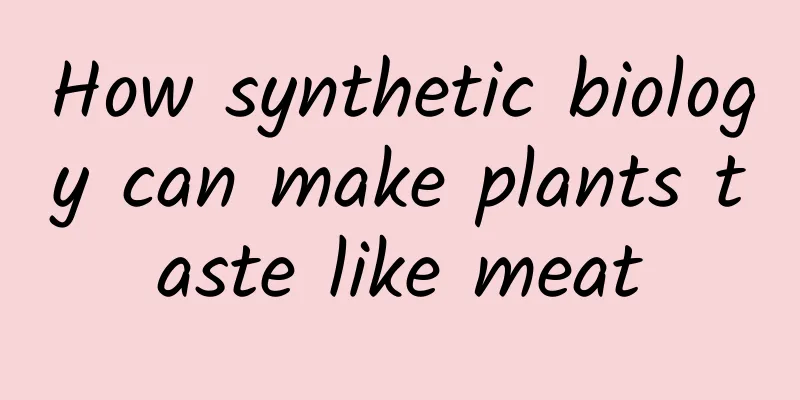How synthetic biology can make plants taste like meat

|
“No bamboo makes people vulgar, no meat makes people thin. To be neither vulgar nor thin, stew pork with bamboo shoots.” At a gathering more than a thousand years ago, the "Poet God" Su Shi wrote this interesting doggerel, which vividly expressed people's love and admiration for meat. Meat is undoubtedly a delicious food with high nutritional value. In addition to being a high-quality protein source, meat is also rich in lipids, zinc, heme iron, vitamin B, etc., which are all necessary for human health. In addition, some proteins in meat, such as gelatin, also play a very important role in the food industry due to their good gelling, emulsifying and water-retaining properties. The demand for meat has surged, and a "new breakthrough" is urgently needed Since the 21st century, with the growth of the world's population, the demand for meat has also increased dramatically. The WHO predicts that by 2030, the global per capita meat consumption will increase to 45.3 kilograms per year. In this case, the meat industry production will need to increase by about 50-72% to meet the food needs of the corresponding population. However, the development of meat products has also brought about many serious problems. On the one hand, animal husbandry is a resource-intensive industry. According to statistics, animal husbandry occupies 70% of the world's agricultural land and consumes 27% of the world's fresh water resources. In addition, greenhouse gas emissions from meat production account for 18% of the world's total emissions, even exceeding the transportation industry (13%). On the other hand, meat products contain a high proportion of cholesterol and saturated fatty acids, which are closely related to the occurrence of metabolic diseases such as cardiovascular disease, high cholesterol, and cancer. In addition, meat may also contain some pathogens, such as avian influenza, salmonella, etc., which threaten the health of consumers. The emergence of artificial meat is expected to meet people's demand for meat while solving related environmental pollution and health problems. There are two main types of artificial meat: The first is "plant meat", which is a kind of food made from plant proteins such as soybeans and wheat through extrusion, electrostatic spinning and other processing technologies, also known as vegetarian meat. In my country, "plant meat" has a history of thousands of years of consumption. As early as the Tang Dynasty, there was a cooking method of "using vegetarian food to support meat". According to "Bei Meng Suo Yan", "the banquet officials used flour and konjac to dye the colors, such as pig shoulder, lamb jerky, and roasted arm, which were all lifelike. People at that time compared it to Emperor Wu of Liang." However, although "plant meat" is rich in protein and cheap, it can only produce "meat flavor" with flavoring, and cannot restore the taste and aroma of meat well. The second type is "cell cultured meat", whose main ingredient is animal protein synthesized directly from cells through cell tissue engineering based on animal stem cells cultured in vitro. Although cell cultured meat contains natural animal protein, cell culture is difficult to simulate the fibrous tissue of meat, and the cost of the culture medium is also high. It is still in the research and development stage. In summary, it is not difficult to find that the production process of plant protein is mature and the cost is low, but the taste is poor; while animal protein is just the opposite, its taste is almost the same as meat, but the production cost is high and it is difficult to produce on a large scale. Plant meat or cell-cultured meat? New artificial meat emerges So, can we combine the advantages of these two and develop a new type of artificial meat? The answer is yes. Impossible Foods is a company dedicated to replacing meat with plants. Based on the concept of synthetic biology, they first studied the mechanism of "meat taste" at the molecular level, then selected proteins and nutrients from plants, and finally restored the taste and nutrition of meat products with plant protein. In 2016, the company's signature product, Impossible Burger, is a hamburger patty based on plant protein with a "meaty taste". Diners said that it was difficult to distinguish it from a real beef burger. So what’s so unique about this plant-based meat alternative? First, in order to create more realistic meat, scientists need to figure out the mechanism of producing "meat flavor". We know that the main component of meat products is muscle, and the biggest feature of muscle is its red color, which is because it contains a large amount of hemoglobin. Hemoglobin is a basic molecule that can carry oxygen and maintain basic life activities. Almost all animals and plants contain hemoglobin, but the content of animal hemoglobin is more than 1,000 times higher than that of plants. Researchers at Impossible Foods discovered that the key to the meaty taste is hemoglobin. During the cooking process, hemoglobin acts as a catalyst to produce hundreds of volatile compounds and form a unique meaty flavor. What's more interesting is that people have found that hemoglobin naturally exists in the root nodules of soybean plants, which is also vividly called "plant blood." Finally, after adding soy hemoglobin, plant-based artificial meat becomes pinker, bloodier, and meatier. However, how to efficiently produce soy hemoglobin is another problem. Although people can extract hemoglobin directly from soybean plants, this method has low yields and consumes a lot of resources. In order to overcome this problem, the Impossible Foods team decided to express hemoglobin heterologously through genetic engineering. Heterologous protein expression refers to a molecular biology technique that uses bacteria, yeast, insect cells, mammalian cells or plant cells to express foreign gene proteins. The Pichia pastoris expression system is widely used due to its low cost, high output, and post-translational modification. Scientists can integrate foreign genes into the yeast genome to give yeast the ability to synthesize new compounds. These foreign genes all come from legumes and are involved in the heme synthesis pathway. As shown in the figure below, the initial substrate ALA undergoes complex chemical reactions and finally obtains the product heme. These reactions are catalyzed by proteases, including dehydratase, deaminase, synthase, etc. After scientists introduced these genes into Pichia pastoris, the yeast also acquired the ability to synthesize heme. Finally, under precise fermentation conditions, Pichia yeast will produce foamy red "plant blood" in the fermentation tank. After filtration and protein purification, scientists finally obtained high-yield, high-purity soy hemoglobin. In July 2018, Impossible Foods' hemoglobin obtained by fermentation passed the FDA's safety review and can be used as a nutrient and colorant for artificial meat. In the future, Impossible Foods plans to further study the molecular mechanism of the "delicious" beef burgers. Scientists connected a gas chromatograph-mass spectrometer to a grill to study the connection between volatile molecules and neural pleasure. After finding the key "aroma molecule", scientists can add it to burgers, like hemoglobin, to make artificial meat more delicious. Make the impossible possible, this is the greatest charm of synthetic biology. Through the study of metabolic engineering, scientists can transplant the synthetic enzyme system of any natural compound into microorganisms for large-scale fermentation production. In addition to heme, more and more natural food additives have appeared, such as vitamin E, stevia, whey protein, etc. They not only make food more nutritious and delicious, but also make the production process more green and efficient. I believe that in the future, there will be more impossible things waiting for us to achieve. References: 1. https://impossiblefoods.com/cn 2. Voigt CA (2020). Synthetic biology 2020-2030: six commercially-available products that are changing our world. Nature communications, 11(1), 6379. https://doi.org/10.1038/s41467-020-20122-2 3. Shi, S., Wang, Z., Shen, L., & Xiao, H. (2022). Synthetic biology: a new frontier in food production. Trends in biotechnology, 40(7), 781–803. https://doi.org/10.1016/j.tibtech.2022.01.002 4. Varadan, R. et al. Ground Meat Replicas (Impossible Foods Inc., 2019). 5. Shankar, S. & Hoyt, MA Expression Constructs and Methods of Genetically Engineering Methylotrophic Yeast, (ed USPTO) (Impossible Foods, USA, 2020). 6. Wang Shengnan, Ma Yuehui, Zhao Guiping, Jiang Lin. Technical characteristics and demand analysis of artificial meat[J]. Acta Animal Husbandry and Veterinary Medicine, 2020, 51(11): 2641-2650. 7. Li Xuejie, Li Jian. Research progress of "artificial meat" as an animal protein substitute[C]//. Proceedings of the Second International Food Safety and Nutrition and Health Summit Forum. [Publisher unknown], 2020:13-17. 8. Liu Fang, Wang Pandi, Xiong Xiaojuan, Zhang Xiaobo, Wu Gang. Current status of artificial meat technology development, safety evaluation and supervision, and consumer acceptance[J]. Chinese Food and Nutrition, 2022, 28(01): 5-9+56. |
<<: Will lemon and milk form lumps when mixed together? Will eating them cause kidney stones?
>>: [Health Science] Why do we not eat or drink before anesthesia?
Recommend
Miscarriage within 3 months
If a woman is sure that she does not want the bab...
What to eat after miscarriage
After a miscarriage, a woman's uterus is seve...
Animal cream, vegetable cream, don't be confused
Cream cakes have always been popular among the pu...
What causes headaches during menstruation?
As a woman, because of the special body structure...
Are uterine fibroids serious?
There are many patients with uterine fibroids in ...
What is the day of female ovulation?
For women's physical health, the normal ovula...
What to do if you have a boil on your vulva
Furuncles are also called furuncles. Furuncles ar...
Rib pain under chest during late pregnancy
Women will feel some discomfort in their chests d...
What is the cause of canna root rot? How to remedy canna root rot?
Canna is a plant with beautiful flowers and is ea...
Several surgical methods for treating cervical erosion
I believe that everyone is familiar with the symp...
One deep and one shallow, but it's my period
The fact that one dark and one light color on the...
What should I do if my pregnant belly is cold?
You still need to pay more attention when your bo...
Female genital castration
What is female genital mutilation? It is a ceremo...
What foot bath is good for gynecological inflammation?
Foot soaking is a good way to maintain health. It...









